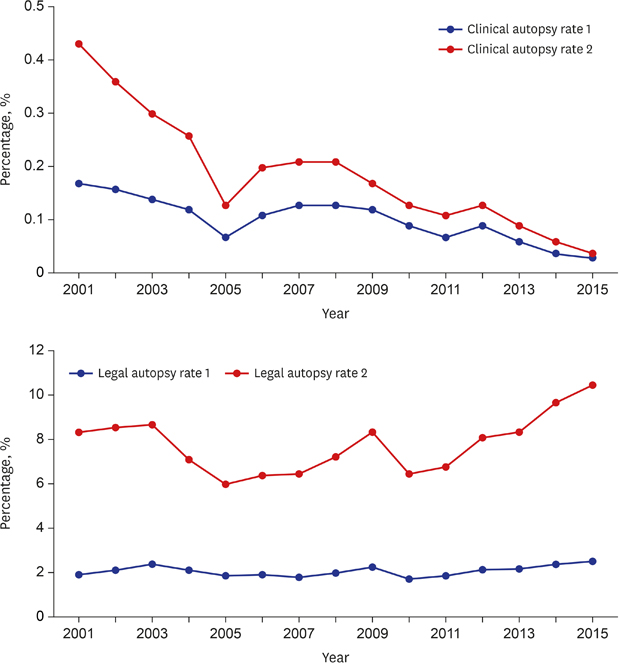1. Woo SD. A statistical observation on medico-legal autopsy and inspection in Korea. Yonsei Med J. 1969; 10(1):71–75.
2. Compilation Committee if the History (1996–2005) of Korean Society of Pathologists. The History of the Korean Society of Pathologists 1996–2005. Seoul: Korean Society of Pathologists;2006.
3. Compilation Committee of the 70-Year History of Korean Society of Pathologists. The History of the Korean Society of Pathologists 2006–2015. Seoul: Korean Society of Pathologists;2016.
4. National Institute of Scientific Investigation. 2002 Annual Report of the National Institute of Scientific Investigation. Seoul: National Institute of Scientific Investigation;2002.
5. National Institute of Scientific Investigation. 2003 Annual Report of the National Institute of Scientific Investigation. Seoul: National Institute of Scientific Investigation;2003.
6. National Institute of Scientific Investigation. 2004 Annual Report of the National Institute of Scientific Investigation. Seoul: National Institute of Scientific Investigation;2004.
7. National Institute of Scientific Investigation. 2005 Annual Report of the National Institute of Scientific Investigation. Seoul: National Institute of Scientific Investigation;2005.
8. National Institute of Scientific Investigation. 2006 Annual Report of the National Institute of Scientific Investigation. Seoul: National Institute of Scientific Investigation;2006.
9. National Institute of Scientific Investigation. 2007 Annual Report of the National Institute of Scientific Investigation. Seoul: National Institute of Scientific Investigation;2007.
10. National Institute of Scientific Investigation. 2008 Annual Report of the National Institute of Scientific Investigation. Seoul: National Institute of Scientific Investigation;2008.
11. National Institute of Scientific Investigation. 2009 Annual Report of the National Institute of Scientific Investigation. Seoul: National Institute of Scientific Investigation;2009.
12. National Forensic Service. 2010 Annual Report of The National Forensic Service. Seoul: National Forensic Service;2010.
13. National Forensic Service. 2011 Annual Report of The National Forensic Service. Seoul: National Forensic Service;2011.
14. National Forensic Service. 2012 Annual Report of The National Forensic Service. Seoul: National Forensic Service;2012.
15. National Forensic Service. 2013 Annual Report of The National Forensic Service. Seoul: National Forensic Service;2013.
16. National Forensic Service. 2014 Annual Report of The National Forensic Service. Wonju: National Forensic Service;2014.
17. National Forensic Service. 2015 Annual Report of The National Forensic Service. Wonju: National Forensic Service;2015.
18. National Forensic Service. 2016 Annual Report of The National Forensic Service. Wonju: National Forensic Service;2016.
20. Hoyert DL. The changing profile of autopsied deaths in the United States, 1972-2007. NCHS Data Brief. 2011; (67):1–8.
22. Yang X, Bai J, Imai H. Changes in autopsy rate in Japanese university hospitals during the past 34 years. Juntendo Med J. 2016; 62(3):240–247.
23. Burton JL, Underwood J. Clinical, educational, and epidemiological value of autopsy. Lancet. 2007; 369(9571):1471–1480.
24. Turnbull A, Osborn M, Nicholas N. Hospital autopsy: endangered or extinct? J Clin Pathol. 2015; 68(8):601–604.
25. Lunetta P, Lounamaa A, Sihvonen S. Surveillance of injury-related deaths: medicolegal autopsy rates and trends in Finland. Inj Prev. 2007; 13(4):282–284.
26. Blokker BM, Weustink AC, Hunink MGM, Oosterhuis JW. Autopsy rates in the Netherlands: 35 years of decline. PLoS One. 2017; 12(6):e0178200.
27. Grassow-Narlik M, Wessolly M, Friemann J. Autopsy rates in Germany. Pathologe. 2017; 38(5):422–429.
28. Kunz SN, Bergsdóttir Þ, Jónasson JG. Autopsy rates in Iceland. Scand J Public Health. 2019; 1403494818820748.
29. Raut A, Andrici J, Severino A, Gill AJ. The death of the hospital autopsy in Australia? The hospital autopsy rate is declining dramatically. Pathology. 2016; 48(7):645–649.
30. Rodewald AK, Bode P, Cathomas G, Moch H. Clinical autopsies in Switzerland: a status report. Pathologe. 2017; 38(5):416–421.
31. Turnbull A, Martin J, Osborn M. The death of autopsy? Lancet. 2015; 386(10009):2141.
32. Levy B. Informatics and autopsy pathology. Surg Pathol Clin. 2015; 8(2):159–174.
33. Fligner CL, Dighe MK. Post-mortem diagnosis: evolving a team approach. Lancet. 2013; 382(9888):186–188.












 PDF
PDF Citation
Citation Print
Print




 XML Download
XML Download